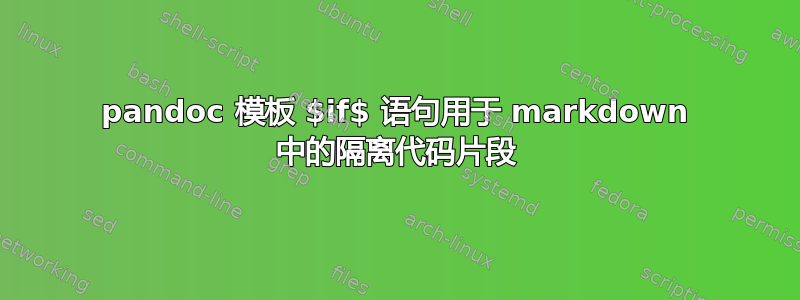
我想知道是否可以在 Pandoc 的 latex.template 中执行以下操作:
\begin{document}
$if(fencedcode)$
\begin{lstlisting}
$content within fenced code$
\end{lstlisting}
$endif$
\end{document}
$content within fenced code$在 markdown 文件中将标记如下(如Pandoc 用户指南:
```bash
#!/bin/bash
echo "hello world"
```
也许为了更好地解释我的问题,我想避免在我的 markdown 文件中写类似这样的内容:
#Introduction
Content…
\begin{lstlisting}{bash}
#!/bin/bash
echo "hello world"
\end{lstlisting}
more content…
因此,使用 less 可以使 markdown 文件更干净、更易于阅读raw latex,就像这样:
#Introduction
Content…
```bash
#!/bin/bash
echo "hello world"
```
more content…
编辑
latex命令\begin{lstlisting}…\end{lstlisting}实际上是文件内的个性化列表命令class.cls。所以我试图实现的是,当source.md使用 pandoc 和相关模板处理文件时,当 Pandoc 看到它fenced code block不是使用常规\begin{listings}命令而是使用个性化命令来处理它\begin{TMcode}…\end{TMcode},该命令定义如下class.cls:
\NeedsTeXFormat{LaTeX2e}
\ProvidesClass{TMarticle}
\LoadClass{article} % we use a standard article as a base-class
\RequirePackage{listings} % for our code listings
\RequirePackage[usenames, dvipsnames, svgnames, table]{xcolor}
\RequirePackage{mdframed}
\RequirePackage{graphicx}
\RequirePackage{calc}
\RequirePackage{array}
\RequirePackage{tabu}
\RequirePackage{longtable}
\RequirePackage{fontspec}
\RequirePackage{amsthm}
\RequirePackage{thmtools}
% color definitions
\definecolor{TMgreen}{RGB}{14, 191, 48}
\definecolor{TMorange}{RGB}{243, 126, 25}
\definecolor{TMred}{RGB}{230, 6, 85}
\definecolor{TMcodeBackground}{RGB}{224, 224, 224}
\definecolor{TMcodeFrame}{RGB}{109, 108, 109}
\definecolor{TMtableHead}{RGB}{230, 6, 85}
\definecolor{TMtableRowTwo}{RGB}{230, 230, 230}
\definecolor{TMtableRowOne}{RGB}{240, 240, 240}
\definecolor{TMemphasis}{RGB}{165, 32, 23}
\definecolor{TMwarning}{RGB}{250, 175, 52}
\definecolor{TMcritical}{RGB}{229, 0, 72}
\definecolor{TMnormal}{RGB}{54, 160, 220}
\definecolor{TMbulletinBackground}{RGB}{224, 224, 224}
\definecolor{TMtheorem}{RGB}{14, 191, 48}
% font settings
\defaultfontfeatures{Ligatures=TeX}
\setmonofont{Source Code Pro Light}[BoldFont=Source Code Pro]
\setmainfont{Lato Light}[
Numbers=OldStyle,
BoldFont=Lato Regular,
ItalicFont=Lato Light Italic,
BoldItalicFont=Lato Italic
]
\setsansfont{Lato Light}[
Numbers=OldStyle,
BoldFont=Lato Regular,
ItalicFont=Lato Light Italic,
BoldItalicFont=Lato Italic
]
\newfontfamily{\titlefont}{Lato Light}[
Numbers=OldStyle,
BoldFont=Lato Regular,
ItalicFont=Lato Light Italic,
BoldItalicFont=Lato Italic
]
% Font for chapter number
\newfontfamily{\upperNumber}{Lato Light}[
BoldFont=Lato Regular,
ItalicFont=Lato Light Italic,
BoldItalicFont=Lato Italic
]
% we now start creating the TM-styled code listing environments
% the lstlisting environment is wrapped in an MD-frame
% first of all we need to define the mdframestyle that
% takes care of the background and the left bar
\mdfdefinestyle{TMstyleCode}{
skipabove=4mm,
skipbelow=0mm,
%remove borders
rightline=false,
topline=false,
bottomline=false,
linewidth=1mm,
%margins
innertopmargin=2mm,
innerleftmargin=0mm,
innerbottommargin=0mm,
innerrightmargin=10pt,
linecolor=TMcodeFrame,
backgroundcolor=TMcodeBackground
}
\lstdefinestyle{TMstyle}{
showstringspaces=false,
numbers=left,
numbersep=7mm,
numberstyle=\color{Black},
stepnumber=1,
tabsize=3,
breakatwhitespace=false,
breaklines=true,
captionpos=b,
basicstyle=\color{Black}\ttfamily,
commentstyle=\color{TMgreen},
keywordstyle=\color{TMorange}\bfseries,
stringstyle=\color{TMred},
frame=leftline,
framesep=0mm,
xleftmargin=3mm,
framesep=2mm,
framerule=0mm,
abovecaptionskip=5mm,
aboveskip=\baselineskip,
belowskip=\baselineskip
}
% need to use inner commands to avoid the verbatim nature
% of listing environments!
\lstnewenvironment{TMcode}[3]
{
\lstset{style=TMstyle, language=#1, caption=#2}
\mdfsetup{style=TMstyleCode}
\mdframed
\hspace*{3mm}
\minipage{0.75cm}
\includegraphics[width=\linewidth]{images/code2.png}
\endminipage
\hspace*{1mm}
\minipage{\textwidth-1.05cm}
{\sffamily\Large #3}
\endminipage
\vspace*{-2mm}
}
{
\endmdframed
}
% We now want to create the bulletin-environments
% we first define two new mdenvironments, one for the header and one for
% the content
\newmdenv[
skipabove=4mm,
skipbelow=1mm,
innertopmargin=1mm,
innerbottommargin=1mm,
innerleftmargin=0mm,
innerrightmargin=0pt,
rightline=false,
topline=false,
bottomline=false,
linewidth=1mm,
frametitlefont={\sffamily\bfseries},
backgroundcolor=TMbulletinBackground]{TMbulletinBase}
\newmdenv[default, linewidth=0pt, backgroundcolor=TMbulletinBackground]{TMbulletinContent}
% we then define three styles, one for each type
\mdfdefinestyle{normal}{linecolor=TMnormal}
\mdfdefinestyle{warning}{linecolor=TMwarning}
\mdfdefinestyle{critical}{linecolor=TMcritical}
% we then define some auxilliary commands
\newcommand{\@TMbulletinTitleContent}[2]
{
\hspace*{2mm}\begin{minipage}{0.75cm}
\includegraphics[width=\linewidth]{#1}
\end{minipage}\hspace*{1mm}\begin{minipage}{\textwidth-1.05cm}
#2
\end{minipage}
}
% and finally the main environment
% takes type (warning/normal/critical) as first argument
% takes bulletin title as second argument
\newenvironment{TMbulletin}[2]{
\begin{TMbulletinBase}[style=#1, frametitle=\@TMbulletinTitleContent{images/#1.png}{#2}]
\vspace*{1mm}
\begin{TMbulletinContent}
}
{
\end{TMbulletinContent}
\end{TMbulletinBase}
}
% we now define the mdtable styles
\newcommand{\tableCaption}{}
\mdfdefinestyle{TMstyleTable}{
skipabove=4mm,
skipbelow=0mm,
%remove borders
rightline=false,
topline=false,
bottomline=false,
linewidth=1mm,
%margins
innertopmargin=0mm,
innerleftmargin=0mm,
innerbottommargin=0mm,
innerrightmargin=0pt,
backgroundcolor=TMcodeBackground,
linecolor=TMtableHead,
}
\everyrow{\tabucline[.4mm white]{}}
\tabulinesep=^3mm_2mm
\taburowcolors[2] 2{TMtableRowOne .. TMtableRowTwo}
\newenvironment{TMtable}[3]
{
\renewcommand{\tableCaption}{#3}
\begin{table}[#2]
\begin{mdframed}[style=TMstyleTable]
\begin{tabu} to \textwidth{#1}
\rowfont{\bfseries\sffamily\leavevmode\color{white}}
\rowcolor{TMtableHead!}
}
{
\end{tabu}
\end{mdframed}
\caption{\tableCaption}
\end{table}
}
% theorem styles
\declaretheoremstyle[
postheadspace=\newline,
headfont=\sffamily\bfseries\large,
mdframed={
skipabove=4mm,
skipbelow=0mm,
rightline=false,
topline=false,
bottomline=false,
linewidth=1mm,
linecolor=TMtheorem,
backgroundcolor=TMcodeBackground,
}
]{TMtheoremStyle}
\declaretheorem[style=TMtheoremStyle, within=section]{theorem}
\declaretheorem[style=TMtheoremStyle, sibling=theorem]{lemma}
\declaretheorem[style=TMtheoremStyle, sibling=theorem]{corollary}
\declaretheorem[style=TMtheoremStyle, sibling=theorem]{proposition}
答案1
更新:
根据您的编辑和评论,您似乎正在问的问题实际上问题是如何更改 pandoc 的 latex 编写器使用的命令。最透明、最直接的方法是编写一个 Lua 过滤器来更改代码块的生成方式。
第一步是弄清楚代码块在 pandoc 的 AST 中是如何内部表示的。你可以通过将示例转换为 来查看发生了什么native,pandoc --to native source.md其中source.md包含
```bash
#!/bin/bash
echo "hello world"
```
输出显示
[ CodeBlock
( "" , [ "bash" ] , [] )
" #!/bin/bash\n echo \"hello world\""
]
现在,第二步是写一个lua 过滤器(我们称之为TMcode.lua)因为CodeBlock返回的是\begin{TMcode} . . . \end{TMcode}而不是\begin{lstlisting} . . . \end{lstlisting}。
function CodeBlock(block)
if FORMAT == "beamer" or FORMAT == "latex" then
local raw_code = string.format(
"\\begin{TMcode}%s\n%s\n\\end{TMcode}",
block.classes[1] and "[language=" .. block.classes[1] .. "]" or "",
block.text
)
return pandoc.RawBlock("latex", raw_code)
end
end
最后,您可以致电pandoc --lua-filter=TMcode.lua --to latex source.md并获取
\begin{TMcode}[language=bash]
#!/bin/bash
echo "hello world"
\end{TMcode}
也许我不明白你的问题。 pandoc 中代码块的语法是:
```bash
#!/bin/bash
echo "hello world"
```
即代码块以刻度而不是点结束。
如果您想使用 lstlisting 环境,您必须使用选项调用 pandoc --listings。
这将生成以下代码:
\begin{lstlisting}[language=bash]
#!/bin/bash
echo "hello world"
\end{lstlisting}
参见https://pandoc.org/MANUAL.html#extension-fenced_code_attributes


